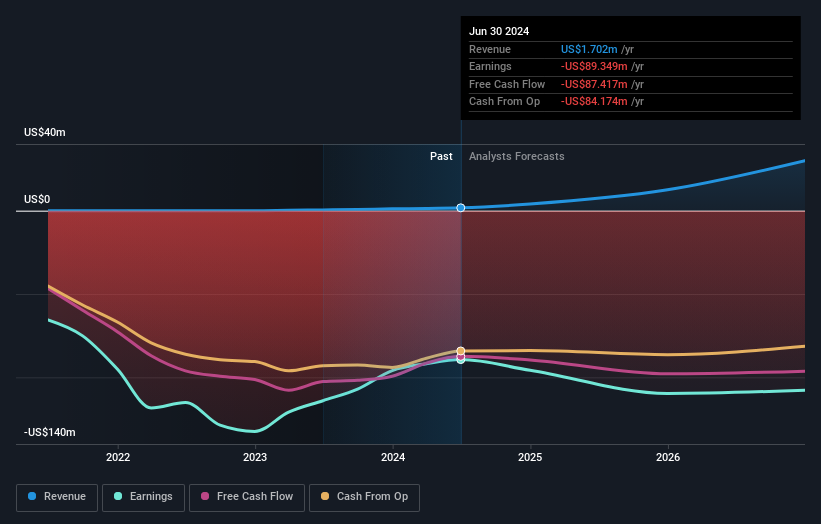- United States
- /
- Life Sciences
- /
- NasdaqGM:QSI
Institutions profited after Quantum-Si incorporated's (NASDAQ:QSI) market cap rose US$23m last week but individual investors profited the most

Key Insights
- The considerable ownership by individual investors in Quantum-Si indicates that they collectively have a greater say in management and business strategy
- A total of 6 investors have a majority stake in the company with 51% ownership
- Insiders have been buying lately
Every investor in Quantum-Si incorporated (NASDAQ:QSI) should be aware of the most powerful shareholder groups. With 38% stake, individual investors possess the maximum shares in the company. In other words, the group stands to gain the most (or lose the most) from their investment into the company.
Following a 18% increase in the stock price last week, individual investors profited the most, but institutions who own 34% stock also stood to gain from the increase.
Let's delve deeper into each type of owner of Quantum-Si, beginning with the chart below.
Check out our latest analysis for Quantum-Si

What Does The Institutional Ownership Tell Us About Quantum-Si?
Institutional investors commonly compare their own returns to the returns of a commonly followed index. So they generally do consider buying larger companies that are included in the relevant benchmark index.
As you can see, institutional investors have a fair amount of stake in Quantum-Si. This implies the analysts working for those institutions have looked at the stock and they like it. But just like anyone else, they could be wrong. When multiple institutions own a stock, there's always a risk that they are in a 'crowded trade'. When such a trade goes wrong, multiple parties may compete to sell stock fast. This risk is higher in a company without a history of growth. You can see Quantum-Si's historic earnings and revenue below, but keep in mind there's always more to the story.

We note that hedge funds don't have a meaningful investment in Quantum-Si. From our data, we infer that the largest shareholder is Jonathan Rothberg (who also holds the title of Top Key Executive) with 26% of shares outstanding. Its usually considered a good sign when insiders own a significant number of shares in the company, and in this case, we're glad to see a company insider play the role of a key stakeholder. In comparison, the second and third largest shareholders hold about 8.7% and 5.5% of the stock.
On further inspection, we found that more than half the company's shares are owned by the top 6 shareholders, suggesting that the interests of the larger shareholders are balanced out to an extent by the smaller ones.
While it makes sense to study institutional ownership data for a company, it also makes sense to study analyst sentiments to know which way the wind is blowing. There is some analyst coverage of the stock, but it could still become more well known, with time.
Insider Ownership Of Quantum-Si
The definition of an insider can differ slightly between different countries, but members of the board of directors always count. Management ultimately answers to the board. However, it is not uncommon for managers to be executive board members, especially if they are a founder or the CEO.
Insider ownership is positive when it signals leadership are thinking like the true owners of the company. However, high insider ownership can also give immense power to a small group within the company. This can be negative in some circumstances.
It seems insiders own a significant proportion of Quantum-Si incorporated. Insiders have a US$40m stake in this US$142m business. It is great to see insiders so invested in the business. It might be worth checking if those insiders have been buying recently.
General Public Ownership
The general public, who are usually individual investors, hold a 38% stake in Quantum-Si. While this size of ownership may not be enough to sway a policy decision in their favour, they can still make a collective impact on company policies.
Next Steps:
It's always worth thinking about the different groups who own shares in a company. But to understand Quantum-Si better, we need to consider many other factors. Like risks, for instance. Every company has them, and we've spotted 3 warning signs for Quantum-Si (of which 1 doesn't sit too well with us!) you should know about.
Ultimately the future is most important. You can access this free report on analyst forecasts for the company.
NB: Figures in this article are calculated using data from the last twelve months, which refer to the 12-month period ending on the last date of the month the financial statement is dated. This may not be consistent with full year annual report figures.
Valuation is complex, but we're here to simplify it.
Discover if Quantum-Si might be undervalued or overvalued with our detailed analysis, featuring fair value estimates, potential risks, dividends, insider trades, and its financial condition.
Access Free AnalysisHave feedback on this article? Concerned about the content? Get in touch with us directly. Alternatively, email editorial-team (at) simplywallst.com.
This article by Simply Wall St is general in nature. We provide commentary based on historical data and analyst forecasts only using an unbiased methodology and our articles are not intended to be financial advice. It does not constitute a recommendation to buy or sell any stock, and does not take account of your objectives, or your financial situation. We aim to bring you long-term focused analysis driven by fundamental data. Note that our analysis may not factor in the latest price-sensitive company announcements or qualitative material. Simply Wall St has no position in any stocks mentioned.
About NasdaqGM:QSI
Quantum-Si
A life sciences company, engages in the development of single-molecule detection platform to enable Next Generation Protein Sequencing (NGPS).
Flawless balance sheet low.

